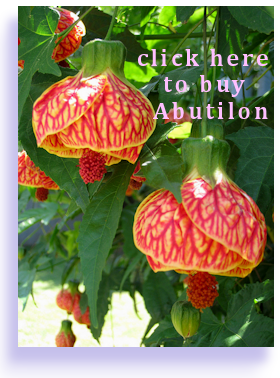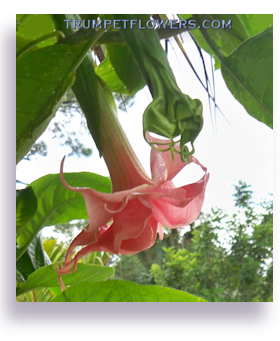Caesalpinia
Pulcherrima
Peacock Tree
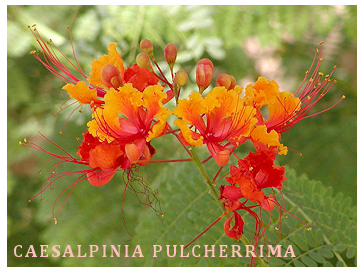 The Peacock Tree is a wonderful small tree or shrub to grow, even if you are not living in the subtropics. Caesalpinia Pulcherrima has many advantages. It is fast growing, and easy to prune and train to shape. It can be used as a hedge, or trained to live in a large patio pot, or grown out in the environment.
The Peacock Tree is a wonderful small tree or shrub to grow, even if you are not living in the subtropics. Caesalpinia Pulcherrima has many advantages. It is fast growing, and easy to prune and train to shape. It can be used as a hedge, or trained to live in a large patio pot, or grown out in the environment.
It blooms freely in a short period of time, and comes in at least 3 different color types. Red with orange, Pink with white, Yellow with orange. What's not to like about this lovely little tree?
Also called 'The Pride of Barbados,' Caesalpinia are found throughout the Carribbean. This is most likely the origin of 'Mexican Bird of Paradise', but it is unknown for sure because of how widespread it's cultivation is.
 Remembering what part of the world I live in helps to understand my quick success with seeds of the lovely Barbados Pride.
It is hardly ever cold here, at least by other people's definition. Our winter consists of lows in the 50's for the most part. So germinating the seeds of Flamboyant-de-Jardin is easy almost year-round.
Remembering what part of the world I live in helps to understand my quick success with seeds of the lovely Barbados Pride.
It is hardly ever cold here, at least by other people's definition. Our winter consists of lows in the 50's for the most part. So germinating the seeds of Flamboyant-de-Jardin is easy almost year-round.
 Sanding and then soaking the seeds first will give you an edge. Take a fingernail file and sand one of the flattened sides until you can see the seed underneath. Then place them in warm water overnight. Plant in a soilless potting soil that comprises of well rotted compost, peat, vermiculite, and osmocote time release feeding beads. Pack the soil firly into a 1 pint pot to start, leaving about 1 inch from the top. Then place the soaked seed into center. Firm 1/2 inch more soil over the top. Deeply water, with rainwater if you have it.
Sanding and then soaking the seeds first will give you an edge. Take a fingernail file and sand one of the flattened sides until you can see the seed underneath. Then place them in warm water overnight. Plant in a soilless potting soil that comprises of well rotted compost, peat, vermiculite, and osmocote time release feeding beads. Pack the soil firly into a 1 pint pot to start, leaving about 1 inch from the top. Then place the soaked seed into center. Firm 1/2 inch more soil over the top. Deeply water, with rainwater if you have it.
If your seeds are older than mine, they may take 2 to 3 weeks to come up. But as long as you nicked the seed coat and presoaked, they should not fail. The seeds stay viable for several years.
If you have it available, vermiculite provides some protection from fungus and mold, as it is antibacterial. Although I didn't do it, you can scatter a thin layer of pure vermiculite across the seeded soil surface to prevent mold from growing there until the seedling sprouts.
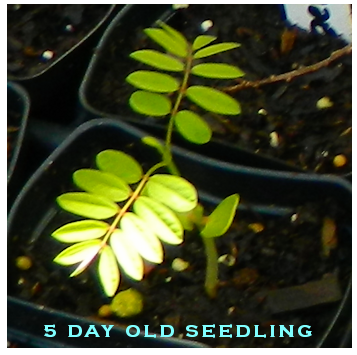 I planted fresh seeds July 15th. The little seedling you see here came up on the 19th. It is now 5 days old. Keep the seedling in moist soil for the first few weeks, but make sure it has good drainage. Overwatering can cause dampen off, a kind of mold that will cause the seedling to wilt and die. Not enough and the seedling will also wither.
Do not attempt to give the seedling any fertilizer or plant food until it has completely absorbed the seed leaves. Seed leaves are the two, fat leaves the plant first came up with. They were a part of the original seed and feed the plant when it is first coming up. After the young plant eats them, you can begin with a weak, 1/2 strength liquid fertilizer, given once a month for the first few months.
I planted fresh seeds July 15th. The little seedling you see here came up on the 19th. It is now 5 days old. Keep the seedling in moist soil for the first few weeks, but make sure it has good drainage. Overwatering can cause dampen off, a kind of mold that will cause the seedling to wilt and die. Not enough and the seedling will also wither.
Do not attempt to give the seedling any fertilizer or plant food until it has completely absorbed the seed leaves. Seed leaves are the two, fat leaves the plant first came up with. They were a part of the original seed and feed the plant when it is first coming up. After the young plant eats them, you can begin with a weak, 1/2 strength liquid fertilizer, given once a month for the first few months.
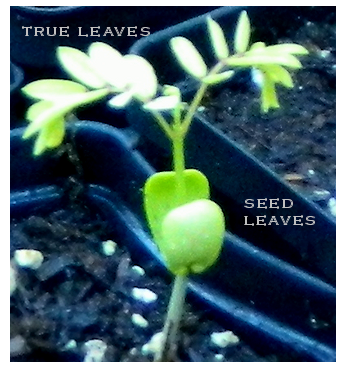 Leave the seedlings in the One pint pots until you see the roots beginning to come out the bottom holes of the pot. Then it is time to repot them up to a One quart pot, that is taller more than wide. Repeat the pot size up routine until the plant has attained the size you want.
Leave the seedlings in the One pint pots until you see the roots beginning to come out the bottom holes of the pot. Then it is time to repot them up to a One quart pot, that is taller more than wide. Repeat the pot size up routine until the plant has attained the size you want.
The Red Bird of Paradise Tree stays manageable in size, so is great for patio pot cultivation. Rarely reaching over 10 feet tall or wide, it is easy to prune into standard (tree) shape or let it go and it will go more bush shape. In warmer climates, (zones 9B and up) it can be planted in the ground, either as a tree. a grove of trees, or even a hedge. In lower climes, (9A and down numerically) you can grow it as an annual or bring it inside to overwinter.
The roots of Caesalpinia Pulcherrima are not invasive. This tree is safe to plant near building foundations and swimming pools, with no threat to cracking the concrete foundation.
 Fertilize the tree 3 to 4 times a year with time-release granulated Palm and Citrus fertilizer. I like the Rite Green brand, because it also contains a few of the micro-elements plant life uses to thrive. You can usually find it in the back of the big box stores like Lowes and Home Depot, in large bags.
Fertilize the tree 3 to 4 times a year with time-release granulated Palm and Citrus fertilizer. I like the Rite Green brand, because it also contains a few of the micro-elements plant life uses to thrive. You can usually find it in the back of the big box stores like Lowes and Home Depot, in large bags.
The trees are easy to care for. They naturally shed their leaves a month or so in Fall, even down here, but regrow them quickly. They are easy to over winter in a cool garage or basement. During that time, water them lightly, but allow them to go into dormancy. When the last threat of frost is over, begin adapting them to the outside again. Slowly return them to full sunlight by leaving them in shadow a week, then moving closer to full sun as the weeks go by.
Tags: Caesalpinia Pulcherrima, peacock tree, The Pride of Barbados, Barbados Pride, Poinciana, Red Bird of Paradise, Mexican Bird of Paradise, Flamboyant-de-jardin, Peacock tree, germinate, grow from seed, care, Caesalpinia Pulcherrima Compton, Yellow Peacock tree, Red Peacock Tree, The Pride of Barbados,

